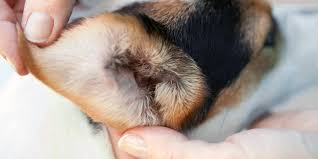
Understanding the neonatal disease in Bovines: Protecting our young calves
Pashu Sandesh, 27 June 2024
Wanere Mangesh Shankar, Sonali Mishra*, Lalita Devi, R.K. Asrani, R.D. Patil and Rakesh Kumar
Department of Veterinary Pathology, Dr G.C. Negi College of Veterinary and Animal Sciences, CSKHPKV, Palampur 176062
*Address for correspondence: Dr Sonali Mishra, Assistant Professor, Department of Veterinary Pathology, Dr GC Negi College of Veterinary and Animal Sciences, CSKHPKV, Palampur 176062 Himachal Pradesh
Introduction
Neonatal diseases in bovines, particularly calves, are a significant concern for farmers and veterinarians. These early-life illnesses can impact calf health, growth, and farm productivity. Understanding the common neonatal diseases, their causes, and prevention strategies is crucial for ensuring the well-being of calves. Common neonatal diseases in bovine calves include calf scours (diarrhoea), pneumonia, naval ill (omphalitis), septicemia, joint ill (septic arthritis), congenital defects (e.g., heart defects, limb deformities), hypothermia, white muscle disease (nutritional muscular dystrophy), neonatal isoerythrolysis (blood type incompatibility), meningitis, bloat (abomasal tympany), coccidiosis, umbilical hernia, respiratory distress syndrome, and metabolic disorders (e.g., hypoglycemia, electrolyte imbalances etc).
- Calf scours or diarrhoea: can be caused by various pathogens, including bacteria ( coli, Salmonella, Campylobacter), viruses (Rotavirus, Coronavirus), and protozoa (Cryptosporidium, Coccidia). Symptoms include diarrhoea, dehydration, weakness, and in severe cases, sternal recumbency followed by death. Prevention involves good colostrum feeding, maintaining clean and dry environments with proper ventilation and sufficient light, and implementing vaccination programmes.
- Pneumonia: Often a result of bacterial (Pasteurella multocida, Mannheimia haemolytica, Mycoplasma bovis) or viral infections (Bovine respiratory syncytial virus - BRSV, Infectious bovine rhinotracheitis virus – IBR), can be exacerbated by environmental factors such as poor ventilation or sudden temperature changes. Symptoms include coughing, laboured breathing, nasal discharge, fever, lethargy, weight loss, reduced appetite, and a rough hair coat. This condition can often progress to septicaemia and multiorgan failure. Prevention includes ensuring proper ventilation, avoiding overcrowding, and providing good nutrition to strengthen immune systems.
- Naval ill or omphalitis: is caused by infection of the umbilical cord stump by bacteria, often due to poor hygiene during and after birth. Symptoms include swelling, heat, discharge at the navel, fever, and lethargy. Prevention involves proper navel care with antiseptic treatment immediately after birth and maintaining a clean birthing environment.

- Joint illness or septic arthritis: is caused by a bacterial infection in the joints (Actinomyces pyogenes and Escherichia coli), often through the bloodstream from other infection sites like the navel. Symptoms include swollen, painful joints, lameness, fever, and reluctance to move. Prevention involves proper hygiene at birth, prompt treatment of naval infections, and ensuring adequate colostrum intake.

- Hypothermia: in calves is caused by exposure to cold temperatures, especially in those born in harsh winter weather conditions. Symptoms include low body temperature, shivering, weakness, and in severe cases, death. Prevention includes providing warm, dry environments for calving, using calf blankets or heat lamps, and ensuring timely colostrum intake for energy.
- White muscle disease, or nutritional muscular dystrophy: is caused by a deficiency of selenium and/or vitamin E in the diet. Symptoms include muscle weakness, stiffness, difficulty standing or walking, and sudden death in severe cases. Prevention involves ensuring adequate dietary intake of selenium and vitamin E through supplements or mineralized feeds.
- Neonatal isoerythrolysis: a condition caused by immune reactions when the dam's antibodies attack the calf's red blood cells due to blood type incompatibility, presents symptoms like jaundice, weakness, rapid heart rate, and anaemia. Prevention includes avoiding breeding combinations known to produce incompatibility and managing colostrum intake from affected dams.
- Meningitis: caused by a bacterial infection (Mycobacterium bovis) spreading to the meninges, often from septicemia or local infections like naval illness, shows symptoms of fever, neck stiffness, lethargy, and neurological signs such as seizures. Prevention involves timely treatment of primary infections, maintaining good hygiene, and ensuring proper colostrum intake.
- Bloat or abomasal tympany: results from rapid fermentation of milk or milk replacer in the abomasum, leading to gas accumulation. Symptoms include abdominal distension, discomfort, bellowing, and in severe cases, difficulty in Prevention includes proper feeding techniques, avoiding overfeeding, and ensuring calves have access to clean water.

- Coccidiosis: a parasitic infection by Eimeria species, that often occurs due to contaminated environments. Symptoms include diarrhoea, weight loss, dehydration, and poor growth. Prevention involves maintaining clean living conditions, regular deworming, and providing coccidiostats in the feed.
- Respiratory distress syndrome: often seen in premature calves, is caused by immature lungs at birth. Symptoms include laboured breathing, cyanosis, and inability to nurse properly. Prevention involves avoiding medications that induce premature birth, ensuring cows have proper nutrition and health during pregnancy, and providing supportive care for at-risk calves.
- Congenital defects: such as heart defects and limb deformities, can be caused by genetic factors, environmental influences during pregnancy, or nutritional deficiencies. Symptoms vary depending on the defect but can include poor growth, difficulty standing or moving, and respiratory issues. Prevention involves proper breeding management, adequate maternal nutrition, and avoiding exposure to harmful substances during pregnancy.
- Umbilical hernia: is caused by incomplete closure of the umbilical ring after birth, with symptoms including soft swelling at the navel that may increase in size over time. Prevention involves proper navel care and avoiding excessive handling of the umbilical area.

Conclusion: Neonatal calf diseases can be prevented with proper management, good nutrition, hygiene and care of the young calves. Colostrum, the first milk produced by the cow post-calving, is rich in antibodies and is vital for newborn calves as it provides passive immunity. Ensuring calves receive adequate colostrum within the first few hours of life is essential for preventing many neonatal diseases. Maintaining hygiene and cleanliness around birthing areas, regular disinfection of feeding and watering equipment, and proper housing are critical factors contributing to the prevention of such diseases. No one can ignore the role of nutrition in a pregnant cow or lactating cow along with the nutrition of calves which are very crucial factors and contribute to the immunity status of the animal. Vaccination schedules recommended by veterinarians should be followed to protect against common pathogens. Regularly monitoring calves for signs of illness and seeking veterinary assistance at the first sign of disease ensures timely treatment and better health outcomes.
By understanding the common diseases, their causes, and prevention strategies, farmers can ensure healthier calves and a more productive herd.
References
- Cho YI, Yoon KJ. An overview of calf diarrhoea-infectious aetiology, diagnosis, and intervention. Journal of Veterinary Science. 2014 Mar;15(1):1.
- Muktar Y, Mamo G, Tesfaye B, Belina D. A review on major bacterial causes of calf diarrhoea and its diagnostic method. Journal of Veterinary Medicine and Animal Health. 2015 May 31;7(5):173-85.
- Bryson DG. Calf pneumonia. Veterinary Clinics of North America: Food Animal Practice. 1985 Jul 1;1(2):237-57.
- Panousis N. Dairy calf pneumonia: effective treatment depends on early and accurate diagnosis. Veterinarski glasnik. 2009;63(3-4):177-87.
- Fecteau G, Smith BP, George LW. Septicemia and meningitis in the newborn calf. Veterinary Clinics of North America: Food Animal Practice. 2009 Mar 1;25(1):195-208.
- Faez Firdaus JA, Muhammad Abubakar Sadiq MA, Konto Mohammed KM, Abdulnasir Tijjani AT, Abba Y, Chung LimTeik [Chung L, Adamu L, Abdinasir Yusuf Osman AY, Mohd Azmi ML, Abdul Wahid Haron AW, Abdul Aziz Saharee AA. A clinical case of navel and joint ill in calf-medical management.
- Newman SJ, Bailey TL, Jones JC, Di Grassie WA, Whittier WD. Multiple congenital anomalies in a calf. Journal of Veterinary Diagnostic Investigation. 1999 Jul;11(4):368-71.
- Gangwar AK, Devi KS, Singh AK, Nitesh Katiyar NK, Ghanshyam Patel GP, Sushanta Srivastava SS. Congenital anomalies and their surgical correction in ruminants.
- Kozat S. Hypothermia in newborn calves. Journal of Istanbul Veterinary Sciences. 2018 Apr 4;2(1):30-7.
- Robinson JB, Young BA. Metabolic heat production of neonatal calves during hypothermia and recovery. Journal of animal science. 1988 Oct 1;66(10):2538-44.
- Rao DR. Selenium Deficiency and White Muscle Disease in California Beef Cattle.
- Stormont C. The aetiology of bovine neonatal isoerythrolysis. The Bovine Practitioner. 1977 Nov 1:22-8.
- Roels S, Walravens K, Saegerman C, Thelissen M, Vanopdenbosch E, Godfroid J. Mycobacterium bovis meningitis in a cow with clinical signs of BSE. The Veterinary Record. 2003 Jun 28;152(26):807.
- Doll K. Tympany and torsion of the abomasum in calves. The Bovine Practitioner. 1991 Sep 1:96-9.
- Kumper H. A new treatment for abomasal bloat in calves. The Bovine Practitioner. 1995 Sep 1:80-2.
- Step DL, Streeter RN, Kirkpatrick JG. Bovine coccidiosis: A review. The Bovine Practitioner. 2002 Jun 1:126-35.
- Verma R, Das G, Saiyam R, Bendigeri S. Clinical coccidiosis in calves and its treatment. Journal of Entomology and Zoology studies. 2018;6(2):2964-7.
- Monteiro FD, Silva CR, da Silva Cardoso T, Neto JD, Teixeira PP. Clinical and surgical approach to umbilical disorders in calves-literature review. Semina: Ciências Agrárias. 2022;43(6):2803-22.
- Bleul U. Respiratory distress syndrome in calves. Veterinary Clinics of North America: Food Animal Practice. 2009 Mar 1;25(1):179-93.
- Karapinar T, Dabak M. Treatment of premature calves with clinically diagnosed respiratory distress syndrome. Journal of Veterinary Internal Medicine. 2008 Mar; 22(2):462-6.
- Naylor JM. New understanding of acid-base imbalances in diarrheic calves: implications for therapy.









































































